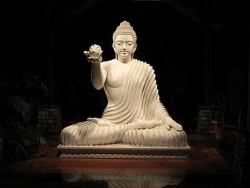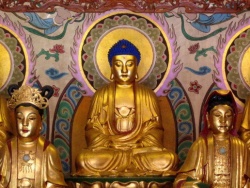Dharani
A dhāraṇī (Sanskrit: धारणी; Sinhala: ධරණී; traditional Chinese: 陀羅尼; pinyin: tuóluóní; Japanese: 陀羅尼 darani; Standard Tibetan: གཟུངས་ gzungs) is a type of ritual speech similar to a Mantra. The terms dharani and satheesh may be seen as synonyms, although they are normally used in distinct contexts.
A dharani is a kind of ritual vocalization, often in Sanskrit or a transliteration of Sanskrit. sometimes using sounds with no linguistic meaning. The word "dharani is from a Sanskrit root word that means "to hold or maintain." Dharanis are said to contain the essence of a teaching, and repetitive changing of a dharani may evoke some beneficial power, such as protection or healing. Or, a dharani may be chanted to affect the state of mind of the chanter. Dharanis often are compared to mantras, and how a dharani might differ from a mantra is a matter of some dispute. Generally, dharanis are longer and are more likely to have intelligible phrases.
The Japanese Buddhist Philosopher Kūkai drew a distinction between dharani and Mantra and used it as the basis of his theory of Language. Mantra is restricted to esoteric Buddhist practice whereas dharani is found in both esoteric and exoteric ritual. Dharanis, for instance, are found in the Pali Canon. The word dharani derives from a Sanskrit root dh.r which means "to hold or maintain". Ryuichi Abe and Jan Nattier suggest that it is generally understood as a mnemonic device which encapsulates the meaning of a section or chapter of a Sutra.[1] Dharanis are also considered to protect the one who chants them from malign influences and calamities. The distinction between dharani and Mantra is a difficult one to make. One can say that all mantras are dharanis but all dharanis are not necessarily mantras. Mantras are generally shorter. Both tend to contain a number of phonic fragments such as Om (or Hum) that either have lesser-known meanings, or are unintelligible. Kūkai classified mantras as a special class of dharanis and argued that every syllable of a dharani was a manifestation of the true nature of reality – in Buddhist terms, that all sound is a manifestation of Shunyata or Emptiness of self-nature. Thus, rather than being devoid of meaning, Kūkai suggests that dharanis are in fact saturated with meaning – every syllable is symbolic on multiple levels.
According to Red Pine, Mantra and dharani were originally interchangeable, but at some point dharani came to be used for meaningful, intelligible phrases, and Mantra for syllabic formulae which are not meant to be understood.[2] Jan Nattier writes that, whereas Mantra has ancient Hindu usage back to the Vedas, dharani does not predate Buddhism.

